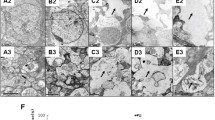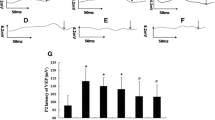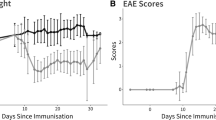Abstract
Human Angiostrongylus cantonensis (A. cantonensis) is a food-borne parasitic disease and can cause optic neuritis. Increasing clinical angiostrongyliasis cases with optic neuritis have been reported, but the pathogenesis has not been fully understood until now. Here, we applied rats with A. cantonensis infection as an animal model to study the pathogenesis of optic neuritis caused by the infection. We observed that the optic disk of experimental rats appeared hyperemic, the retina vein became thick, and the visual evoked potential (VEP) latency was prolonged. There were obvious inflammatory cell infiltration in the retina and optic nerve adventitia followed with obvious optic nerve fiber demyelination and retina ganglion swelling. We also evaluated the effect of dexamethasone combined with albendazole on optic neuritis of rats infected with A. cantonensis. The results showed it had no obvious effect to prevent progressive visual deterioration for optic neuritis caused by A. cantonensis. The studies provided evidence that the pathogenesis of optic neuritis in infected rats was correlated to optic nerve demyelination and ganglion cell damage caused by optic nerve inflammation, and the common therapy to this disease was not so effective. Based on the above results, it may be necessary to combine neuroprotective agents with common therapy to treat and protect optic nerve and ganglion cells from their secondary injury.







Similar content being viewed by others
References
Beck RW, Cleary PA, Anderson MM Jr, Keltner JL, Shults WT, Kaufman DI, Buckley EG, Corbett JJ, Kupersmith MJ, Miller NR et al (1992) A randomized controlled trial of corticosteroids in the treatment of acute optic neuritis. The Optic Neuritis Study Group. N Engl J Med 326:581–588
Chen D, Zhang Y, Shen H, Wei Y, Huang D, Tan Q, Lan X, Li Q, Chen Z, Li Z, Ou L, Suen H, Ding X, Luo X, Li X, Zhan X (2011) Epidemiological survey of Angiostrongylus cantonensis in the west-central region of Guangdong Province, China. Parasitol Res 109:305–314
Diao Z, Wang J, Qi H, Li X, Zheng X, Yin C (2011) Human ocular angiostrongyliasis: a literature review. Trop Dr 41:76–78
Feng Y, Nawa Y, Sawanyavisuth K, Lv Z, Wu ZD (2013) Comprehensive review of ocular angiostrongyliasis with special reference to optic neuritis. Korean J Parasitol 51:613–619
Fleming JO (2013) Helminth therapy and multiple sclerosis. Int J Parasitol 43:259–274
Graeff-Teixeira C, da Silva AC, Yoshimura K (2009) Update on eosinophilic meningoencephalitis and its clinical relevance. Clin Microbiol Rev 22:322–348
Ketsuwan P, Pradatsundarasar A (1966) Second case of ocular angiostrongyliasis in Thailand. Am J Trop Med Hyg 15:50–51
Kjølhede T, Vissing K, Dalgas U (2012) Multiple sclerosis and progressive resistance training: a systematic review. Mult Scler 18:1215–1228
Lan KP, Wang CJ, Lai SC, Chen KM, Lee SS, Hsu JD, Lee HH (2004) The efficacy of therapy with albendazole in mice with parasitic meningitis caused by Angiostrongylus cantonensis. Parasitol Res 93:311–317
Liu IH, Chung YM, Chen SJ, Cho WL (2006) Necrotizing retinitis induced by Angiostrongylus cantonensis. Am J Ophthalmol 141:577–579
Maki J, Yanagisawa T (1986) Studies on anthelmintic effects of flubendazole and mebendazole on the rat lungworm Angiostrongylus cantonensis in mice and rats. J Parasitol 72:512–516
Meyer R, Weissert R, Diem R, Storch MK, de Graaf KL, Kramer B (2001) Acute neuronal apoptosis in a rat model of multiple sclerosis. J Neurosci 21:6214–6220
Noseworthy JH, Lucchinetti C, Rodriguez M, Weinshenker BG (2000) Multiple sclerosis.N Engl J Med 343:938–952
Park HY, Kim JH, Park CK (2012) Activation of autophagy induces retinal ganglion cell death in a chronic hypertensive glaucoma model. Cell Death Dis. doi:10.1038/cddis.2012.26
Pojda-Wilczek D (2010) Retrospective analysis of pattern VEP results in different ocular and systemic diseases. Klin Oczna 112:205–209
Quinn TA, Dutt M, Shindler KS (2011) Optic neuritis and retinal ganglion cell loss in a chronic murine model of multiple sclerosis. Front Neurol 2:50–55
Rosenberg HF, Dyer KD, Foster PS (2013) Eosinophils: changing perspectives in health and disease. Nat Rev Immunol 13:9–22
Rothenberg M, Hogan P (2006) The eosinophil. Annu Rev Immunol 24:147–174
Sawanyawisuth K (2008) Treatment of angiostrongyliasis. Trans R Soc Trop Med Hyg 102:990–996
Shindler KS, Ventura E, Dutt M, Rostami A (2008a) Inflammatory demyelination induces axonal injury and retinal ganglion cell apoptosis in experimental optic neuritis. Exp Eye Res 87:208–213
Shindler KS, Ventura E, Dutt M, Rostami A (2008b) Ocular angiostrongyliasis: clinical study of three cases. Eye (Lond) 22:1446–1448
Sinawat S, Sanguansak T, Angkawinijwong T, Ratanapakorn T, Intapan PM, Sinawat S, Yospaiboon Y (2008) Ocular angiostrongyliasis: clinical study of three cases. Eye (Lond) 22:1446–1448
Toma H, Matsumura S, Oshiro C, Hidaka T, Sato Y (2002) Ocular angiostrongyliasis without meningitis symptoms in Okinawa, Japan. J Parasitol 88:211–213
Tselis A, Perumal J, Caon C, Hreha S, Ching W, Din M, Van Stavern G, Khan O (2008) Eur J Neurol 15:1163–1167
Wang WJ, Lv JH, He YL (1999) A case of Angiostrongyliasis cantonensis taken out from retina with operation on vitreous. Chin J Ophthalmol 35:470–471
Wang LC, Wang IH, Jou JR (2006) Optic neuritis secondary to Angiostrongylus cantonensis infection. Ocul Immunol Inflamm 14:189–191
Wang J, Zheng XY, Yin CH, Qi HY, Li XL, Diao ZL, Wang F, Ji AP, Feng ML, Guo ZZ (2007) Clinical observation on 25 cases of severe Angiostrongyliasis Cantonensis. Chin J Parasitol Parasit Dis 25:333–336
Wang J, Wei J, Zeng X, Liang JY, Wu F, Li ZY, Zheng HQ, He HJ, Wu ZD (2013) Efficacy of tribendimidine against Angiostrongylus cantonensis infection in the mice. Parasitol Res 112:1039–1046
Wei FR, Liu HX, Lv S, Hu L, Zhang Y (2010) Multiplex PCR assay for the detection of Angiostrongylus cantonensis larvae in Pomacea canaliculata. Zhongguo Ji Sheng Chong Xue Yu Ji Sheng Chong Bing Za Zhi 28:355–358
Xiang MD, Zhang MD, Li DN, Mao YN (2001) A report about Angiostrongyliasis cantonensis in anterior chamber of a child’s eye. Chin J Strabismus Pediatr Ophthalmol 9:91–92
Yang SQ, Yu BW, Chen YS, Hu QX, Zhu SH, Wang XB, Wang L (1988) The first human case of angiostrongyliasis cantonensis in the mainland of China. Chin Med J (Engl) 101:783–786
You Y, Klistorner A, Yang SQ, Yu BW, Chen YS, Hu QX, Zhu SH, Wang XB, Wang L (1988) The first human case of Angiostrongyliasis cantonensis in the mainland of China. Chin Med J (Engl) 101:783–786
Acknowledgments
The authors would like to thank Zhongshan Ophthalmic Center, Sun Yat-sen University, for providing the apparatus for ophthalmologic examination of this article. This work was supported in part by the National Natural Science Foundation of China (No. 81261160324 and No. 81271855) “973” project (No. 2010CB530000) of China and The PhD Start-up Fund of Natural Science Foundation of Guangdong Province of China (No. 4203021) grant.
Author information
Authors and Affiliations
Corresponding author
Rights and permissions
About this article
Cite this article
Feng, Y., Zeng, X., Li, Wh. et al. Animal model of human disease with optic neuritis: neuropapillitis in a rat model infected with Angiostrongylus cantonensis . Parasitol Res 113, 4005–4013 (2014). https://doi.org/10.1007/s00436-014-4067-6
Received:
Accepted:
Published:
Issue Date:
DOI: https://doi.org/10.1007/s00436-014-4067-6




